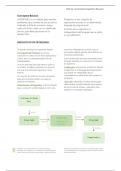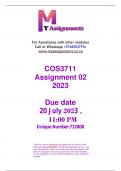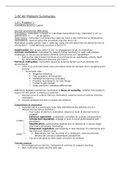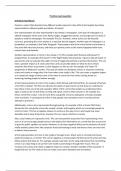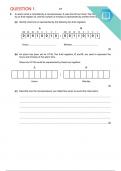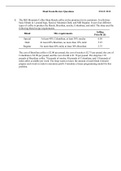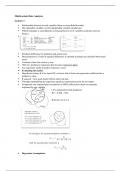2 IMRAN YAMIN teaching since 1992 ( 0322-6175556)
SEP 2021 AS PHYSICS BY SIR IMRAN YAMIN
1.MEASUREMENT 2.KINEMATICS 3.DYNAMICS 4.WORK 5.PRESSURE,DENSITY
6.DEFORMATION 7.ELECTRIC FIELD 8.CURRENT ELECTRICITY 9.D.C CIRCUITS
10.WAVES 11.RADIOACTIVITTY 0322 6175556
UNITS & MEASUREMENT
Content: SI units, Prefixes, Errors and uncertainties Scalars and vectors, CRO
Estimation Calibration Graph
Physical Quantities;
Those quantities, which are measurable are called Physical Quantities. All physical quantities consist of a numerical
magnitude and a unit.
There are seven base quantities .From the seven base quantities, you can obtain all the other physical quantities. The
table of fundamental units of S.I system is given below:
Physical Quantity S.I. unit Abbreviation
Length metre m
Mass Kilogram Kg
Time Second Sec
Temperature Kelvin K
Current Ampere A
Luminous Intensity Candela Cd
Amount of Substance Mole Mol
Derived Units: The units which are obtained with the help of two or more fundamental units, are called derived
units.
Physical Quantity Symbol for Name of Unit Symbol for Unit
Quantity
Speed V Meter per second m/sec
Acceleration A Meter per second square m/sec2
Force F Newton N
Pressure P Pascal Pa (N/m2)
Frequency Υ Hertz Hz
Area A Meter square m2
Charge Q Coulomb C (As)
Power P Watt W (J/Sec)
Electric resistance R Ohm Ω
Capacitance C Farad F (C / V)
Electric field strength E Newton per Coulomb N/C
Magnetic flux density B Tesla T (Wb/m2)
Specific heat Q Joules per Kilogram per
J/kg. K
Kelvin
Prefixes
Decca D 10¹ Deci d 10⁻1
Hecto H 10² Centi c 10⁻2
Kilo K 10³ Milli m 10⁻3
Mega M 10⁶ Micro 10⁻6
Giga G 10⁹ Nano n 10⁻9
Tera T 10¹² Pico p 10⁻12
,3 IMRAN YAMIN teaching since 1992 ( 0322-6175556)
Reading: is a single determination of the value of an unknown quantity
Measurement: is the final result of the analysis of series of reading.
Any quantity measured has an amount of uncertainty or error.
Error: The difference b/w observed value and actual value is called Error.
Uncertainty: The total range of values within which a measurement likely to lie is called uncertainty.
it is the acceptable error in the measurement values.
Length = (25 ± 0.5 ) = (x ± Δ x ) x is absolute value and Δ x is absolute uncertainty.
Fractional uncertainty: It is the ratio of absolute uncertainty to the absolute value.
∆ ∆
Fractional uncertainty= and percentage uncertainty= . 100
Q.1 To measure the length of a wire , the acceptable error is 0.45 m, its percentage uncertainty is 4 %,
calculate the actual length.
Q.2 The resistance of a wire is 28 ohm and its acceptable error is 2.5 %, find the absolute error.
UNCERTAINTY OPERATIONS
Compound Error : Uncertainties in the measurement of various physical quantities are compounded, which
results in a larger error or uncertainty.
OPERTION .1 (When quantities are in addition or subtraction form, their absolute uncertainties are added)
Addition U= x+ y If ± Δ x and ± Δ y are errors then ΔU = ± (Δ x + Δ y)
Subtraction U= x- y If ± Δ x and ± Δ y are errors then Δ U = ± (Δ x + Δ y)
,4 IMRAN YAMIN teaching since 1992 ( 0322-6175556)
(Absolute uncertainties can only have 1 SF. Absolute value is rounded off to the same number
of d.p as the uncertainty)
OPERTION .2 (When quantities are in multiplication or division form, calculate fractional
uncertainties, add them to each other, it will be the total fractional uncertainty, but the total value of
uncertainty is calculated by multiplying this fraction with the calculated absolute value)
∆ ∆ ∆
PRODUCT: U= x . y = + Total fractional uncertainty
∆ ∆
=( + ) U Total value of uncertainty
U = ( X.Y ) ±
“Quantities are multiplied and fractional uncertainties are added”
∆ ∆ ∆
DIVISION: U = = +
“ Quantities are divided and fractional uncertainties are added”
Q: The dimensions of a box are
l = (5.0 ± 0.2) cm b= (4.0±0.1)cm
h = (8.0±0.2)cm v= l x b x h
OPERATION .3 (When quantities contain exponents, their fractional uncertainties multiplied with
exponent value then are added)
Q. Mass of block of metal is (11.5±0.5)kg and volume is (1.000±20)cm3. How would you express the
density of metal?
EXPONENT: U= x n .ym
∆ ∆ ∆
= +
Q. The diameter of wire is (0.56±0.01)mm. What is the cross sectional area of wire?
Q. What is the percentage error in the density of steel ball, if mass uncertainly is within 1% and
diameter within 3%.
Conclusion
For a quantity x = (2.0± 0.1) mm,
∆
Actual/ Absolute uncertainty, Δx = ± 0.1 mm Fractional uncertainty, 0.05
∆
Percentage uncertainty, 100% = 5 % Actual error must be recorded to only 1 significant figure.
( October/ November 2018 - Paper 11)
A digital meter has an accuracy of ±1%. The meter is used to measure the current in an electrical circuit. The reading
on the meter varies between 3.04 A and 3.08 A. What is the value of the current, with its uncertainty?
A (3.06 ± 0.02) A B (3.06 ± 0.04) A C (3.06 ± 0.05) A D (3.06 ± 0.07) A
, 5 IMRAN YAMIN teaching since 1992 ( 0322-6175556)
Value of current is taken as an average value of the two values varies between 3.04 A and 3.08 A.
I = (3.04 + 3.08) / 2 = 3.06 A
Uncertainty for the current is considered in two cases.
One; when the current is not fluctuating or remains constant at 3.06 A, which will have an uncertainty of ±1%.
Uncertainty 1 = ±1% x 3.06 = 0.0306 A
Two; when the current is fluctuating or varies between 3.04 A and 3.08 A where the uncertainty may be calculated using
the half range method as follows.
Uncertainty 2 = (3.08 - 3.04) / 2 = 0.02 A
Thus, the uncertainty is considered in taking into account of both cases where
uncertainty in I = uncertainty 1 + uncertainty 2 = 0.0306 + 0.02 = 0.0506 A = 0.05 A (1sf)
Absolute uncertainty in current is taken in 1 significant figure (sf) as 0.05 A.
I = (3.06 ± 0.05) A Answer: C
SCALARS: Those physical quantities, which can be expressed by the magnitude, unit and without
direction, are called SCALAR QUANTITIES.
VECTORS: Those physical quantities, which can be expressed by the magnitude, unit and with
direction, are called VECTOR QUANTITIES.
ADDITION OF VECTORS
(i) Head to Tail Rule
Two or more vectors can be added such that head of one vector coincides with the tail of the other and
the resultant is obtained by joining the tail of the first vector and the head of the last one. This method of vector
addition is ‘head to tail rule’.
(ii) Parallelogram law Method
If two vectors originate from a common point then we consider them two adjacent sides of a
parallelogram. The parallelogram is completed and the diagonal of the parallelogram gives the resultant of the
two vectors. This is known as parallelogram law.
(iii) LAW OF COSINE:
Magnitude of resultant can be obtain by
Then the resultant R = A 2 B 2 2 ABCos
Where A & B are the vectors & is the angle b/w them.
(Two head, Two tails use plus, one head one tail use minus)
When two vectors are perpendicular to each other, R2 = A2 +B2 ( Pythagoras theorem)
iMRAN YAMiN 0322 6175556
SEP 2021 AS PHYSICS BY SIR IMRAN YAMIN
1.MEASUREMENT 2.KINEMATICS 3.DYNAMICS 4.WORK 5.PRESSURE,DENSITY
6.DEFORMATION 7.ELECTRIC FIELD 8.CURRENT ELECTRICITY 9.D.C CIRCUITS
10.WAVES 11.RADIOACTIVITTY 0322 6175556
UNITS & MEASUREMENT
Content: SI units, Prefixes, Errors and uncertainties Scalars and vectors, CRO
Estimation Calibration Graph
Physical Quantities;
Those quantities, which are measurable are called Physical Quantities. All physical quantities consist of a numerical
magnitude and a unit.
There are seven base quantities .From the seven base quantities, you can obtain all the other physical quantities. The
table of fundamental units of S.I system is given below:
Physical Quantity S.I. unit Abbreviation
Length metre m
Mass Kilogram Kg
Time Second Sec
Temperature Kelvin K
Current Ampere A
Luminous Intensity Candela Cd
Amount of Substance Mole Mol
Derived Units: The units which are obtained with the help of two or more fundamental units, are called derived
units.
Physical Quantity Symbol for Name of Unit Symbol for Unit
Quantity
Speed V Meter per second m/sec
Acceleration A Meter per second square m/sec2
Force F Newton N
Pressure P Pascal Pa (N/m2)
Frequency Υ Hertz Hz
Area A Meter square m2
Charge Q Coulomb C (As)
Power P Watt W (J/Sec)
Electric resistance R Ohm Ω
Capacitance C Farad F (C / V)
Electric field strength E Newton per Coulomb N/C
Magnetic flux density B Tesla T (Wb/m2)
Specific heat Q Joules per Kilogram per
J/kg. K
Kelvin
Prefixes
Decca D 10¹ Deci d 10⁻1
Hecto H 10² Centi c 10⁻2
Kilo K 10³ Milli m 10⁻3
Mega M 10⁶ Micro 10⁻6
Giga G 10⁹ Nano n 10⁻9
Tera T 10¹² Pico p 10⁻12
,3 IMRAN YAMIN teaching since 1992 ( 0322-6175556)
Reading: is a single determination of the value of an unknown quantity
Measurement: is the final result of the analysis of series of reading.
Any quantity measured has an amount of uncertainty or error.
Error: The difference b/w observed value and actual value is called Error.
Uncertainty: The total range of values within which a measurement likely to lie is called uncertainty.
it is the acceptable error in the measurement values.
Length = (25 ± 0.5 ) = (x ± Δ x ) x is absolute value and Δ x is absolute uncertainty.
Fractional uncertainty: It is the ratio of absolute uncertainty to the absolute value.
∆ ∆
Fractional uncertainty= and percentage uncertainty= . 100
Q.1 To measure the length of a wire , the acceptable error is 0.45 m, its percentage uncertainty is 4 %,
calculate the actual length.
Q.2 The resistance of a wire is 28 ohm and its acceptable error is 2.5 %, find the absolute error.
UNCERTAINTY OPERATIONS
Compound Error : Uncertainties in the measurement of various physical quantities are compounded, which
results in a larger error or uncertainty.
OPERTION .1 (When quantities are in addition or subtraction form, their absolute uncertainties are added)
Addition U= x+ y If ± Δ x and ± Δ y are errors then ΔU = ± (Δ x + Δ y)
Subtraction U= x- y If ± Δ x and ± Δ y are errors then Δ U = ± (Δ x + Δ y)
,4 IMRAN YAMIN teaching since 1992 ( 0322-6175556)
(Absolute uncertainties can only have 1 SF. Absolute value is rounded off to the same number
of d.p as the uncertainty)
OPERTION .2 (When quantities are in multiplication or division form, calculate fractional
uncertainties, add them to each other, it will be the total fractional uncertainty, but the total value of
uncertainty is calculated by multiplying this fraction with the calculated absolute value)
∆ ∆ ∆
PRODUCT: U= x . y = + Total fractional uncertainty
∆ ∆
=( + ) U Total value of uncertainty
U = ( X.Y ) ±
“Quantities are multiplied and fractional uncertainties are added”
∆ ∆ ∆
DIVISION: U = = +
“ Quantities are divided and fractional uncertainties are added”
Q: The dimensions of a box are
l = (5.0 ± 0.2) cm b= (4.0±0.1)cm
h = (8.0±0.2)cm v= l x b x h
OPERATION .3 (When quantities contain exponents, their fractional uncertainties multiplied with
exponent value then are added)
Q. Mass of block of metal is (11.5±0.5)kg and volume is (1.000±20)cm3. How would you express the
density of metal?
EXPONENT: U= x n .ym
∆ ∆ ∆
= +
Q. The diameter of wire is (0.56±0.01)mm. What is the cross sectional area of wire?
Q. What is the percentage error in the density of steel ball, if mass uncertainly is within 1% and
diameter within 3%.
Conclusion
For a quantity x = (2.0± 0.1) mm,
∆
Actual/ Absolute uncertainty, Δx = ± 0.1 mm Fractional uncertainty, 0.05
∆
Percentage uncertainty, 100% = 5 % Actual error must be recorded to only 1 significant figure.
( October/ November 2018 - Paper 11)
A digital meter has an accuracy of ±1%. The meter is used to measure the current in an electrical circuit. The reading
on the meter varies between 3.04 A and 3.08 A. What is the value of the current, with its uncertainty?
A (3.06 ± 0.02) A B (3.06 ± 0.04) A C (3.06 ± 0.05) A D (3.06 ± 0.07) A
, 5 IMRAN YAMIN teaching since 1992 ( 0322-6175556)
Value of current is taken as an average value of the two values varies between 3.04 A and 3.08 A.
I = (3.04 + 3.08) / 2 = 3.06 A
Uncertainty for the current is considered in two cases.
One; when the current is not fluctuating or remains constant at 3.06 A, which will have an uncertainty of ±1%.
Uncertainty 1 = ±1% x 3.06 = 0.0306 A
Two; when the current is fluctuating or varies between 3.04 A and 3.08 A where the uncertainty may be calculated using
the half range method as follows.
Uncertainty 2 = (3.08 - 3.04) / 2 = 0.02 A
Thus, the uncertainty is considered in taking into account of both cases where
uncertainty in I = uncertainty 1 + uncertainty 2 = 0.0306 + 0.02 = 0.0506 A = 0.05 A (1sf)
Absolute uncertainty in current is taken in 1 significant figure (sf) as 0.05 A.
I = (3.06 ± 0.05) A Answer: C
SCALARS: Those physical quantities, which can be expressed by the magnitude, unit and without
direction, are called SCALAR QUANTITIES.
VECTORS: Those physical quantities, which can be expressed by the magnitude, unit and with
direction, are called VECTOR QUANTITIES.
ADDITION OF VECTORS
(i) Head to Tail Rule
Two or more vectors can be added such that head of one vector coincides with the tail of the other and
the resultant is obtained by joining the tail of the first vector and the head of the last one. This method of vector
addition is ‘head to tail rule’.
(ii) Parallelogram law Method
If two vectors originate from a common point then we consider them two adjacent sides of a
parallelogram. The parallelogram is completed and the diagonal of the parallelogram gives the resultant of the
two vectors. This is known as parallelogram law.
(iii) LAW OF COSINE:
Magnitude of resultant can be obtain by
Then the resultant R = A 2 B 2 2 ABCos
Where A & B are the vectors & is the angle b/w them.
(Two head, Two tails use plus, one head one tail use minus)
When two vectors are perpendicular to each other, R2 = A2 +B2 ( Pythagoras theorem)
iMRAN YAMiN 0322 6175556

